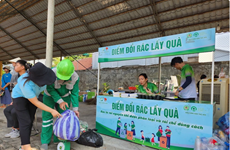Dam-building threatens Mekong environment
Economic development on the Mekong River is short-sighted and
unsustainable, environmentalists heard at a meeting in Hanoi on
August 3.
Economic development on the Mekong River is short-sighted and
unsustainable, environmentalists heard at a meeting in Hanoi on
August 3.
The meeting, entitled Mekong: Energy – Environment – Livelihood Security, was co-organised by PanNature, a Hanoi-based non-profit organisation; the Vietnam Rivers Network, comprising civil society groups, academics and community-based organisations; and the Henry L Stimson Centre, an independent, non-profit, public policy institute.
Delegates heard that the biggest threat to the future of the river, its fauna and flora, is the need to dam the Mekong for hydro-power. The Mekong Delta in Vietnam is particularly vulnerable, participants heard.
The 4,800km Mekong flows through six countries – China , Myanmar , Thailand , Laos , Cambodia and Vietnam . The Lower Mekong Basin
in Thailand , Laos , Cambodia and Vietnam is home to more than 60 million residents from more than 100 different ethnic groups.
Most of them are poor farmers and fishermen, whose livelihoods are dependent on the river.
Representatives from PanNature said the Mekong is home to a diverse array of fish fauna, worth billions of dollars, that provide food security for poor communities in the river's 795,000sq.km basin.
Participants heard that economic development and poverty alleviation are threatening the livelihoods of those who make a living from the river.
Participants watched a 15-minute video-clip entitled Mekong – The Tipping Point, that highlighted the dangers of damming the river for hydro-power projects.
Timothy Hamlin, from the Henry L Stimson Centre, said that development in Vietnam need not threaten human security and regional stability.
About 50 participants from key government agencies, Vietnamese NGOs and research institutions attended the meeting./.
The meeting, entitled Mekong: Energy – Environment – Livelihood Security, was co-organised by PanNature, a Hanoi-based non-profit organisation; the Vietnam Rivers Network, comprising civil society groups, academics and community-based organisations; and the Henry L Stimson Centre, an independent, non-profit, public policy institute.
Delegates heard that the biggest threat to the future of the river, its fauna and flora, is the need to dam the Mekong for hydro-power. The Mekong Delta in Vietnam is particularly vulnerable, participants heard.
The 4,800km Mekong flows through six countries – China , Myanmar , Thailand , Laos , Cambodia and Vietnam . The Lower Mekong Basin
in Thailand , Laos , Cambodia and Vietnam is home to more than 60 million residents from more than 100 different ethnic groups.
Most of them are poor farmers and fishermen, whose livelihoods are dependent on the river.
Representatives from PanNature said the Mekong is home to a diverse array of fish fauna, worth billions of dollars, that provide food security for poor communities in the river's 795,000sq.km basin.
Participants heard that economic development and poverty alleviation are threatening the livelihoods of those who make a living from the river.
Participants watched a 15-minute video-clip entitled Mekong – The Tipping Point, that highlighted the dangers of damming the river for hydro-power projects.
Timothy Hamlin, from the Henry L Stimson Centre, said that development in Vietnam need not threaten human security and regional stability.
About 50 participants from key government agencies, Vietnamese NGOs and research institutions attended the meeting./.













